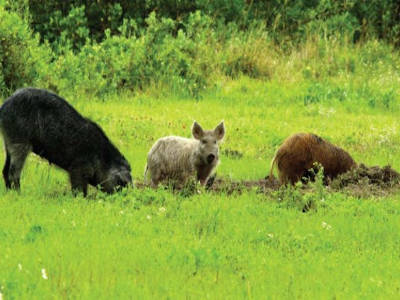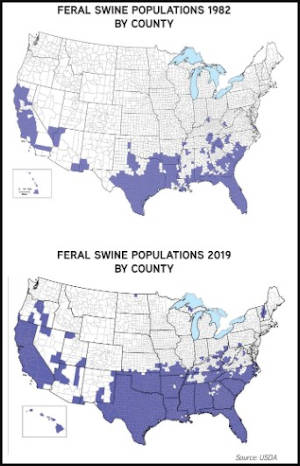By R. Scott Nolen
Feral pigs are a destructive and dangerous invasive species costing the United State an estimated $1.5 billion annually in damages and control costs. And the problem is getting worse.
In 1982, feral pigs were rooting, wallowing, and reproducing in 17 states. But by 2020, the species had spread to at least 38 states, according to the U.S. Department of Agriculture, which estimates the size of the wild pig population is at least 6 million and rapidly expanding.
“I’ve heard it referred to as a feral swine bomb,” said Dale Nolte, manager of the USDA’s National Feral Swine Damage Management Program, in a Sept. 19 article in The Atlantic magazine.
“They multiply so rapidly. To go from a thousand to two thousand, it’s not a big deal,” Nolte said. “But if you’ve got a million, it doesn’t take long to get to 4 [million], then 8 million.”

With their long snouts and tusks, feral pigs are rooting a destructive path across the nation.
Congress responded to the increasing damage and disease threats posed by the expanding feral pig populations by appropriating funds to the USDA Animal and Plant Health Inspection Service in 2014 to create the National Feral Swine Damage Management Program, with the goal of protecting agricultural and natural resources, property, animal health, and human health and safety by managing damage caused by feral swine.

In 2019, 84,223 feral pigs were euthanized in dozens of states as part of the NFSDMP. Those numbers mark a nearly 15% increase from 2018, when 73,443 feral pigs were euthanized.
Feral pigs are not a native species. They were brought to the United States in the 1500s by explorers and settlers as a source of food. Free-range livestock management practices and escapes from enclosures led to the first establishment of feral swine populations within the United States.
During the 1900s, the Eurasian, or Russian, wild boar was introduced into parts of the United States for sport hunting. The troublesome feral pigs today are a combination of escaped domestic pigs, Eurasian wild boars, and hybrids of the two.
A 1999 study in California found that multiple hunting-related introductions contributed to the range expansion of wild pigs from about 10 coastal counties in the early 1960s to 49 of the state’s 58 counties by 1996.
Adult feral pigs typically weigh between 75 and 250 pounds but can grow twice as large. They can reach 3 feet in height and 5 feet in length and run up to 30 miles per hour. Females breed year-round, having up to two litters of between four and 12 piglets annually.
Click here to see more...